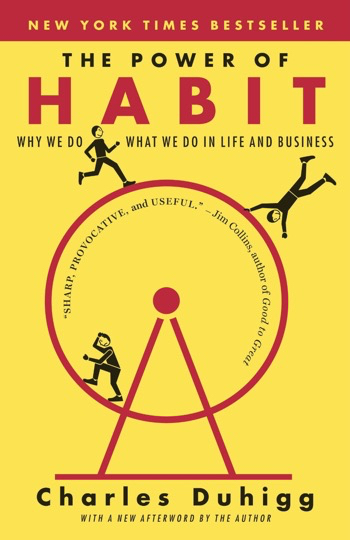 I said to a group of friends over the weekend, “Hey, I just started reading this great book called The Power of Something”. Everyone laughed because it’s always a book about the power of something or other with me. Perhaps that’s my habit—I see a book title promising to explain the power within some aspect of the human experience, and I follow my routine through purchasing, reading and reviewing the book. Then I get my reward in the way of interesting anecdotes and a convincing display of intellect.
I said to a group of friends over the weekend, “Hey, I just started reading this great book called The Power of Something”. Everyone laughed because it’s always a book about the power of something or other with me. Perhaps that’s my habit—I see a book title promising to explain the power within some aspect of the human experience, and I follow my routine through purchasing, reading and reviewing the book. Then I get my reward in the way of interesting anecdotes and a convincing display of intellect.
So yes, The Power of Habit by Charles Duhigg, is another one of those books. It reads similar to others such as Freakonomics, Outliers or Blink. Each chapter, while vaguely referencing research, relies heavily on a few specific case studies to tell a compelling story. The primary difference, in my opinion, between Duhigg’s text and the others, is that The Power of Habit is self verifiable. To some extent. Unless you refuse to look in the proverbial mirror of the mind, Duhiggs words will probably ring true right away.
It’s a very good book.
There are two central concepts in The Power of Habit. Those are “The Habit Loop” and “Keystone Habits”. The rest is good, but if a reader captured those two ideas alone, the rest might just fall into place on its own.
The habit loop is what it sounds like. Habits are things we do compulsively, nearly automatically. Sometimes we’re done doing the thing before we even wonder why we did it. Smoking, eating too much or too badly, binge watching tv, being late for work, acting defensively, quitting stuff. The habit loop is like water flowing through the same path it eroded out for itself over time, or a piece of paper which refolds easily once it’s done the first time.
In the habit loop there is a cue, a routine and a reward. For most people toting smartphones, the cue might be the buzz against your leg when the phone vibrates, which starts the automatic routine of removing the phone from your pocket and checking your text messages, followed by the reward of seeing that little red dot on the application icon disappear. For a lot of people this routine is automatic—they know there’s nothing about that buzz that requires they take the following steps, yet good conversations are regularly interrupted by the urge to carry out the habit. For a lot of people, that cue works its way backwards even further. Just noticing the phone is in their pocket is enough to cue the routine. For some, remembering it exists, or seeing someone else using theirs is enough to do it.
We also know that habits literally change the structure of the brain, which is why once we’ve developed a habit, it will always be easier to return to that habit than to form a brand new one. Again, like a piece of paper that’s creased and then spread out again. If you toss it out into the wind, as it tumbles around, it will most likely fold itself back into its creases rather than makes new ones.
So according to the research (and my observations of myself) habits can’t just be removed—that would mean immediately reshaping your brain—they have to be replaced with other habits. The same water has to be redirected to erode out new streams. Reshaping the brain to play out new habits takes gradual effort, eventually making it easier to automatically use the new habit than the old one. Which brings us to the second major point, “Keystone Habits”.
Keystone habits are the ones that a lot of other things pivot around. They’re the securing link at the beginning of a chain of habits. For example, someone might have a habit of binge watching TV right after work. When they get home, they take off their shoes, change clothes, grab a few beers, and sit down on the couch. The keystone habit, in this case, might be the removing their shoes, which acts as a cue to change their clothes, which leads to the rewards of beer and motionlessness in front of the television.
Keystone habits are the most efficient place to affect change in habits because just a small disruption can redirect the flow of the whole routine. If this person wanted to change their evening habit, they could disrupt the habit of removing their shoes. This might lead to remaining in work-clothes longer, and perhaps increase the likelihood that they’ll do the dishes and cook dinner before relaxing—a healthier habit for most.
The ability to redirect habits isn’t in creating a vacuum, though. You don’t want to leave your shoes on and just hope you get to the dishes. You’ll probably just end up taking off your shoes anyway and doing what you always do. When a keystone habit is disrupted, something needs to fill the gap. When you know what you want your habit to be, a better keystone habit can be used. Instead of taking off your shoes, maybe you change into your ‘housework’ shirt, which cues the routine of getting the dishes done.
I’ve noticed this effect in my own life with exercise. I wanted to get more exercise, but knew I’d dread it all day if I didn’t do it first thing. So I started with just 1 minute first thing in the morning after brushing my teeth. After a while, I started to associate the fresh feeling in my mouth with the need to exercise. Now, simply brushing my teeth creates a burst of energy to exercise at almost any time.
The Power of Habit, in the aggregate however, is oversimplified. You can tell because it’s extremely easy to understand. I’m not really joking when I say that either. The human experience is complicated and we don’t understand it quite as well as Duhigg lays out. He simplifies and creates tender analogies in order to make a broad and multifaceted topic actionable and useful to the average person. Much like Malcolm Gladwell does and is often criticized for. But even so, I think the ideas in The Power of Habit are personally verifiable. That doesn’t necessarily make them totally accurate, just worth treating that way.

Recent Discussion